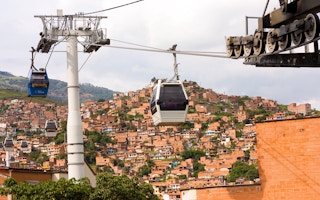Inequality is a choice according to Don Chen, director of equitable development at the Ford Foundation, a US-based research foundation that looks at advancing human welfare. It is driven by political policies, access to resources and decision-making processes that have been reinforced over many years and which are especially pronounced in urban areas.
Therefore, city authorities must make the policy choices now to safeguard the future equitable delivery of housing, health and transport services that growing urban populations depend on.
Chen’s remarks come as tens of thousands of urban planners, government officials, businesses and NGOs seek agreement on the New Urban Agenda, a roadmap for the equitable development of cities, at the UN’s Habitat III conference on housing and sustainable urban development in Quito, Ecuador, from October 17-20.
“It’s going to be challenging,” Chen told a World Resources Institute (WRI) press briefing. “We have to hold each other accountable for the progress we want to make,” he added.
Around 60 per cent of the world’s population will live in cities by 2050, with the highest rates of urbanisation in poor counties, according to a new WRI report. This marks a departure from past patterns and necessitates new approaches and the involvement of new actors, as cities will play a crucial role in meeting the UN’s new Sustainable Development Goals and the Paris Agreement on Climate Change.
“
Cities don’t change overnight. The basic assumption that as cities grow richer they will fix themselves actually doesn’t work.
Ani Dasgupta, World Resources Institute
Six billion city dwellers
In the next three decades, the number of people living in cities will increase by 2.5 billion to 6 billion, with around 90 per cent of urbanisation occurring in the southern hemisphere, mostly in Asia and Africa.
Failing to provide services for these populations can have harmful long-term environmental implications and can undermine citizens’ economic productivity, the WRI report Towards a More Equal City says.
According to WRI’s Ani Dasgupta, the infrastructure decisions made by city authorities, many of which are constrained by limited finances and institutional capacity, can endure for 30 or 40 years.
“Cities don’t change overnight,” Dasgupta told chinadialogue. “The basic assumption that as cities grow richer they will fix themselves actually doesn’t work,” he added.
What is needed, Dasgupta says, is dialogue between national and local governments in order to avoid the high-energy consumption pathways that cities have taken in the past. Investing in public transport now, for example, will not just reduce a city’s emissions but will also connect people to centres of education and economic activity. These skills and resources can be channelled into making cities resilient to climate shocks.
Medellín and Surat: getting it right
Medellín in Colombia is often cited as an example of transformative urban development. With a population of around 2.5 million, Medellín is Colombia’s second largest city and was once the murder capital of the world. It has since become a modern, thriving city as local authorities and the private sector have worked together to provide innovative solutions to the needs of its citizens.
For example, in 2012, the city’s urban regeneration plan delivered a cable car that connects previously isolated communities in informal hillside settlements to the city centre, as well as an escalator that enabled access to goods and services for inaccessible neighbourhoods such as Comuna 13.
The WRI report also identifies Surat, on the west coast of India, whose city authorities enacted a plan to clean up waste management and water systems following an outbreak of disease. This also involved the reinforcement of flood defences.
But can these examples be scaled-up to megacities in fast-growing countries like China?
“Megacities have international dialogue among themselves,” Ian Klaus, senior advisor for global cities at the US state department, told chinadialogue. Klaus suggested that bigger cities have their own challenges and don’t necessarily need the help of national governments to share best practices. However, this is not the case for secondary or tertiary cities, which will account for the majority of urban growth in the coming years.
New urban agenda
Habitat III is the first UN-organised summit on sustainable urban development since governments, NGOs, businesses and other stakeholders met in Istanbul in 1996. It provides the first opportunity in a generation for communities to have a say in how their cities develop, Chen said.
The UN’s New Urban Agenda, a set of policy goals to tackle urban poverty and inequality, will be formally agreed on October 20 at the end of Habitat III and will be complimented by the Quito implementation plan, which outlines over 800 commitments.
“It’s not about the number, in fact you have less commitments, but they’re implementable ones,” said Ana Moreno, secretariat coordinator of Habitat III.
Cooperation between and among cities of the global North and South is also a priority, Moreno added.
This story was originally published by Chinadialogue under a Creative Commons’ License and was republished with permission.










